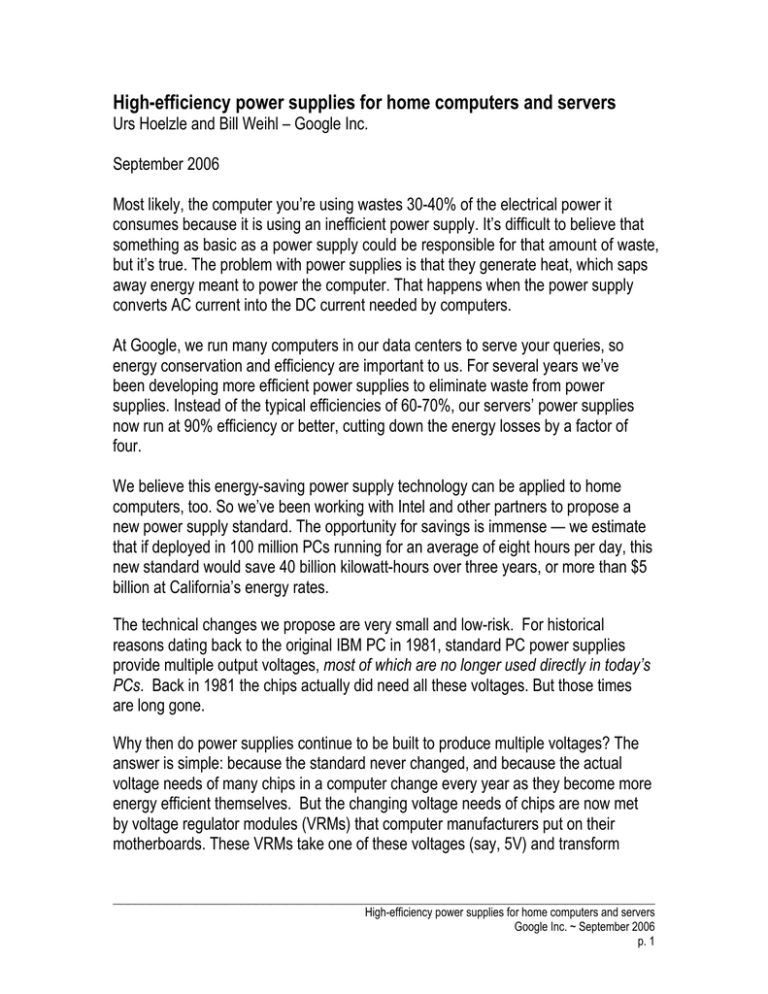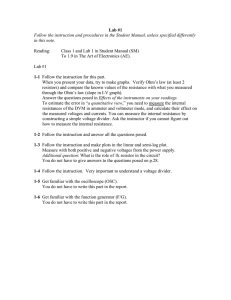High-efficiency power supplies for home computers and servers
advertisement

High-efficiency power supplies for home computers and servers Urs Hoelzle and Bill Weihl – Google Inc. September 2006 Most likely, the computer you’re using wastes 30-40% of the electrical power it consumes because it is using an inefficient power supply. It’s difficult to believe that something as basic as a power supply could be responsible for that amount of waste, but it’s true. The problem with power supplies is that they generate heat, which saps away energy meant to power the computer. That happens when the power supply converts AC current into the DC current needed by computers. At Google, we run many computers in our data centers to serve your queries, so energy conservation and efficiency are important to us. For several years we’ve been developing more efficient power supplies to eliminate waste from power supplies. Instead of the typical efficiencies of 60-70%, our servers’ power supplies now run at 90% efficiency or better, cutting down the energy losses by a factor of four. We believe this energy-saving power supply technology can be applied to home computers, too. So we’ve been working with Intel and other partners to propose a new power supply standard. The opportunity for savings is immense — we estimate that if deployed in 100 million PCs running for an average of eight hours per day, this new standard would save 40 billion kilowatt-hours over three years, or more than $5 billion at California’s energy rates. The technical changes we propose are very small and low-risk. For historical reasons dating back to the original IBM PC in 1981, standard PC power supplies provide multiple output voltages, most of which are no longer used directly in today’s PCs. Back in 1981 the chips actually did need all these voltages. But those times are long gone. Why then do power supplies continue to be built to produce multiple voltages? The answer is simple: because the standard never changed, and because the actual voltage needs of many chips in a computer change every year as they become more energy efficient themselves. But the changing voltage needs of chips are now met by voltage regulator modules (VRMs) that computer manufacturers put on their motherboards. These VRMs take one of these voltages (say, 5V) and transform ________________________________________________________________________ High-efficiency power supplies for home computers and servers Google Inc. ~ September 2006 p. 1 them down to the actual voltage needed (say, 1.7V) making multiple voltage output capability of power supplies unnecessary. Providing multiple output voltages complicates the design of power supplies, and it makes it harder to build efficient power supplies. In essence, manufacturers have to build four different power supplies: one each for +12V, -12V, 5V, and 3.3V outputs. The picture below shows the innards of a typical power supply—it looks so complicated because it really comprises four power supplies in one. Because each motherboard may draw different amounts of power on each voltage, manufacturers overprovision the supply for each individual voltage in order to support multiple options. Since power supplies are most efficient near their maximum rated loads, this overprovisioning leads to lower efficiency. The VRMs (voltage regulator modules) used internally are also a significant source of loss. Typical current efficiencies (including power supply and VRM losses) are in the 55-60% range today, i.e., power supplies use 65-80% more power than necessary. Google servers, and the new PC standard we propose, use a simple 12V power supply. The power supply generates a single voltage, and all other voltages required by motherboard components will be generated on the motherboard itself via VRMs. The picture below shows such a power supply—note how many fewer parts it has. ________________________________________________________________________ High-efficiency power supplies for home computers and servers Google Inc. ~ September 2006 p. 2 The net result of these changes is a dramatic improvement in efficiency (including the power supply and the regulators) to about 85%, at virtually no cost. In other words, you won’t have to pay more for a higher-efficiency PC, because the power supply is actually getting simpler, not more complicated. By spending another $20 or so extra, it is possible to use higher-quality components and achieve efficiencies well over 90%. You won’t be able to buy such computers for a while, and Google isn’t planning on selling you any. But we’re working with industry partners such as Intel to make this technology an open standard that everyone can use, and that all vendors hopefully will adopt. It’s the right solution technically, and the right thing to do for the environment. If you'd like us to keep you posted on our progress, please send us a note at efficient-psu@google.com. ________________________________________________________________________ High-efficiency power supplies for home computers and servers Google Inc. ~ September 2006 p. 3







